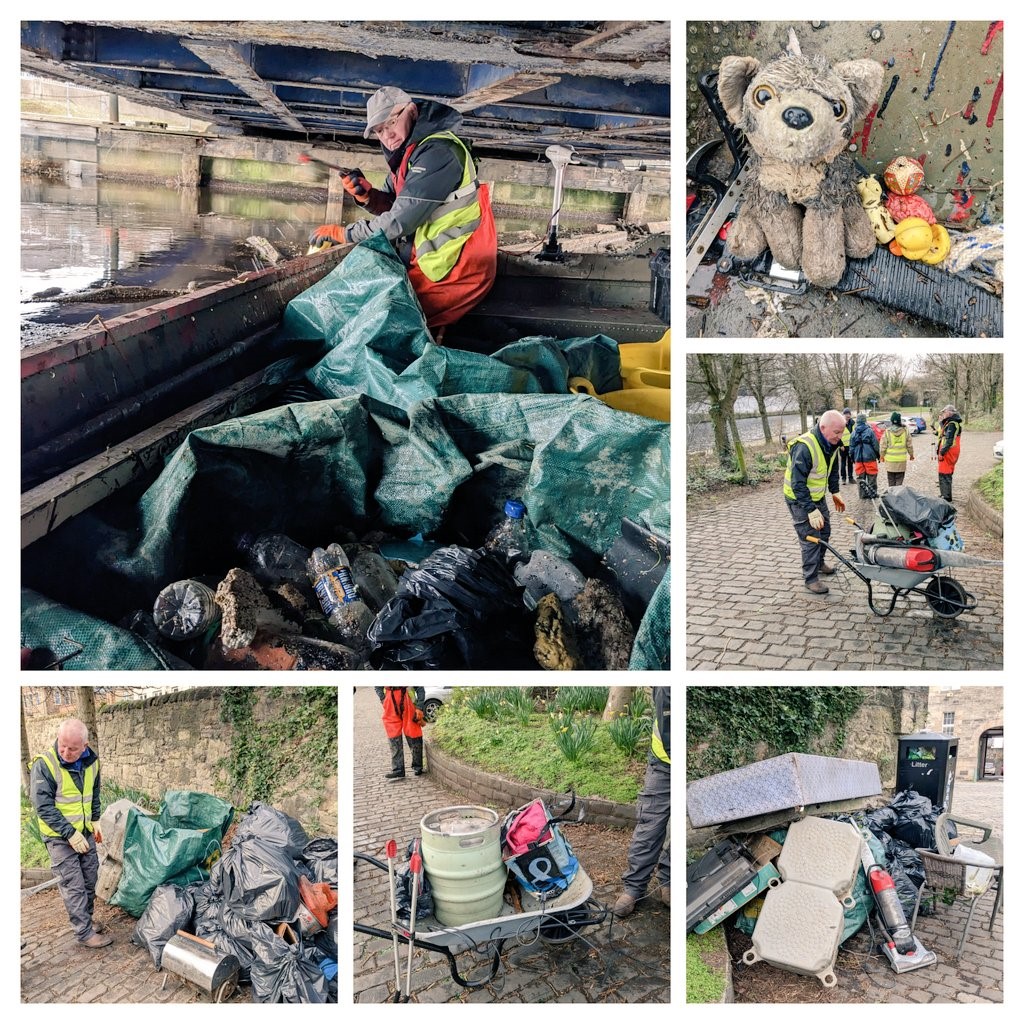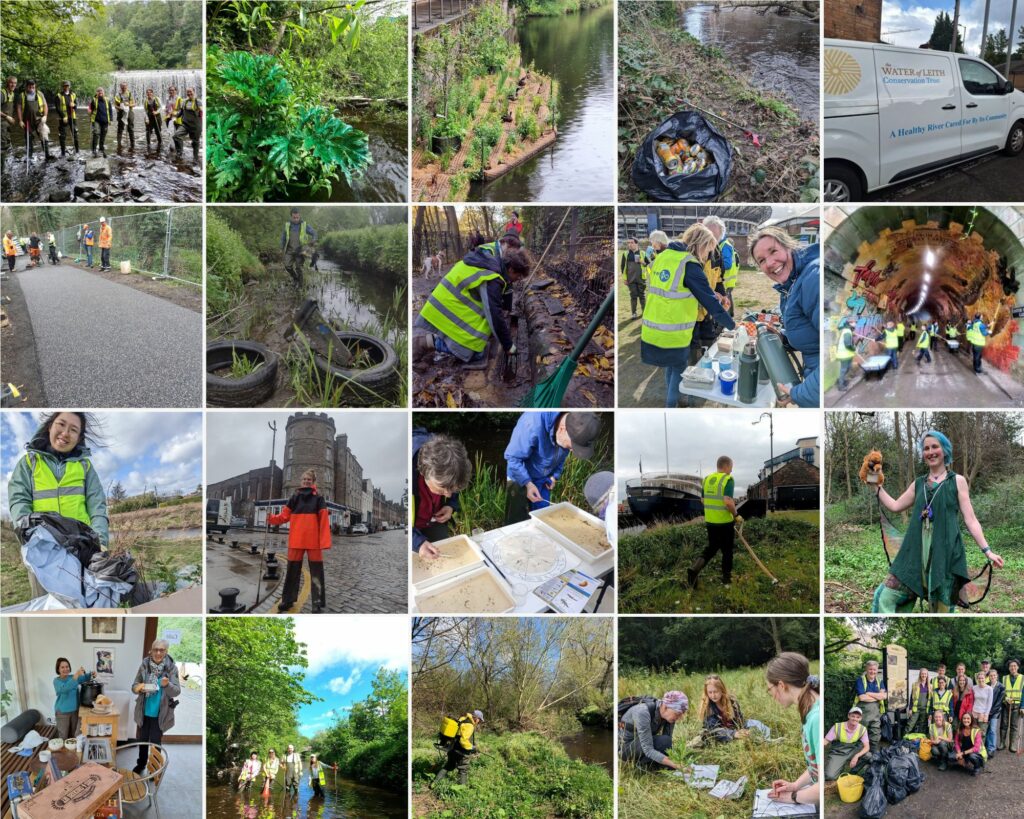Since April we have seen many changes within the team and along the river. We started the year welcoming four new members of staff to the team and grew our volunteer team to over 500 members. There were landmark achievements: the installation of two water quality and habitat enhancing Biomatrix platforms in Leith, record engagement in conservation tasks, the development of our survey teams to include riverflies and fungi and huge investment in improvements to the Water of Leith Walkway. Plus we saw our outdoor learning work return to pre-pandemic levels and welcomed an unprecedented amount of High School Students to our programmes. At the Visitor Centre we broadened its appeal by offering ‘soup and games’ sessions to our local community helping to tackle winter loneliness and a raft of events aimed at three to six-year olds invited a new audience to connect with the river. We also developed and published a new five-year strategy based on the following pillars of Protect, Improve, Connect, Learn and Entrust – which you can download below and we set a new vision of:
‘a healthy river cared for by its community’

Volunteer Action.
Led by Ranger Johnny, Conservation Officer Hannah and our ‘New to Nature’ Trainee Michael, the number of volunteer hours devoted to protecting and improving the river rose to over 6000 hours in just 9 months. On 191 conservation task – an average of nearly five tasks every week! These include:
• 95 river clean-ups including 9 boat clean-ups in Leith*
• 56 tasks to survey, treat and manage Invasive Non Native Species (INNS) *
• 57 tasks maintaining the Water of Leith walkway and adjoining path network*.
• 25 tasks scything, raking and planting wildflower meadows and maintaining our Community Gardens
*tasks often involve more than one activity – i.e. we collect litter while wading the river treating INNS
Our eyes and ears, the Patrol Team have also conducted a record 195 volunteer river patrols.
The number of local businesses lending a hand also rose this year as 35 groups joined in river clean-ups and walkway maintenance sessions, plus 36 community groups including our regular group of young adults with learning difficulties – the Peregrine Group.
The year also saw the growth of our new Survey Teams, who attended 30 survey sessions along the river. This work ensures our conservation efforts are improving biodiversity and recording helps to monitor the resilience of wildlife as our climate changes, highlighting issues and potential losses. We now have three survey teams:
• Plant identification who focused on surveying our 8 wildflower meadows. https://www.waterofleith.org.uk/blog/2023/09/meadow-surveys-the-results/
• The river fly team surveyed four locations monthly over 6 months to track the health of these pollution indicating species. https://www.waterofleith.org.uk/blog/2024/01/riverfly-surveys-the-results-for-2023/
• The Fungi team who have identified 109 species in and around the Dells, include 10 rare species, over 5 months. https://www.waterofleith.org.uk/blog/2023/11/michaels-fungi-adventures-in-the-dells/
Sustaining this level of delivery for the river and its community is so important for the river’s wildlife, its users and for our volunteer team as it is helping to combat the loneliness and isolation of individuals who come along on a regular basis.

Visitor Centre, Learning and Communications
Our volunteer-run Visitor Centre in Slateford is open daily and has welcomed over 15,000 people since April, supported by Gillan and Kat our Centre team. We offer drinks, snacks and gifts from our Community Cafe and a whole series of engagement events and activities. Spring saw our first Wild Welly Walk for under 6’s, over the summer and autumn we delivered 25 public events for young people, guided walks and talks, and we ran a very popular Christmas Fayre. This Autumn saw us launch ‘Souper Fridays’, a chance to come along to the Visitor Centre, enjoy a delicious bowl of soup and some company, board games and chat with our volunteers.
https://www.waterofleith.org.uk/blog/2023/12/2023-at-the-visitor-centre/
Learning is at the heart of everything we do, from tiny tots learning though play at the Centre to Stirling University Methods and Applications in Environmental Science students carrying out real life water quality monitoring. Led by Ruth, our learning officer, since April we have welcomed 67 schools group to experience our diverse outdoor learning programmes. With the reintroduction of the higher geography assignments we have been very busy with geography field studies, both our Centre-based study in the Craiglockhart Dells and our Source to Sea study which starts in the Pentland Hills and ends up in Stockbridge. We delivered a record 21 over the last term alone with more booked for the spring.
In addition, 49 community groups have joined us for walks, talks or ‘hands on fun’ sessions. Overall that is 141 learning sessions – over 3 and a half each week.
Greenspaces and Biodiversity
Improving the river’s greenspace took a big leap forward as, after years of planning, our transformative Coalie Park Improvement Project has begun. In May two Biomatrix platform were installed in Leith – floating ecosystems which help to restore degraded waterways. They provide somewhere safe to rest and breed for the river’s bird and fish life, plus they will work to improve water quality. At the end of November the site was closed as contractors moved in to begin the installation of new path surfaces, planters, benches, cycle parking, which have been designed to improve movement though the site while also allowing for pauses to enjoy the greenspace.
Looking after the walkway is at the core of our work and the volunteer have spent a muscle aching 1800 hours scraping, sweeping and cutting back the edges of 13 miles of path network, plus restoring blocked drains and repairing fences: like having a person working full time all year round keeping the route accessible. The Trust also supported the delivery of a major walkway resurfacing project along five miles of the Walkway from Balerno to Slateford and the reinstatement of Redhall bridge in the Dells.
This year we focused attention on the Murrayburn, a badly polluted and giant hogweed infested tributary. Clean-ups revealed decades of rubbish and accumulations of wet wipes and sanitary products. We also investigated the rural Cockburn for Himalayan Balsam and the Oriel burn for poor water quality. Long term, we’d like to get into these tributaries more to reduce invasive species, increase tree cover and biodiversity to benefit the Water of Leith.
We still focus work on the management of INNS, 155 hours and 35 tasks were spent in the treatment of Giant Hogweed. Our monitoring work shows after eight years it’s really making a difference upstream from Slateford with just a few hundred plants remaining. We have been working downstream and along tributaries for just three years so there is still a long way to go to get this area under control. After over 10 years of volunteers hand pulling Himalayan balsam in the catchment this plant is much reduced, with less than 120 hours spent on its removal. Proving our efforts against these invaders is finally working.
In addition, we lead the Water of Leith Action Group and contribute to the Edinburgh Biodiversity Partnership, Nature Network development and the assessment of ‘Local Biodiversity Sites’.
This all possible thanks to many generous donations from individuals, local companies, charitable trusts and grant funding – especially City of Edinburgh Council. You can support our work by donating or becoming a member.



